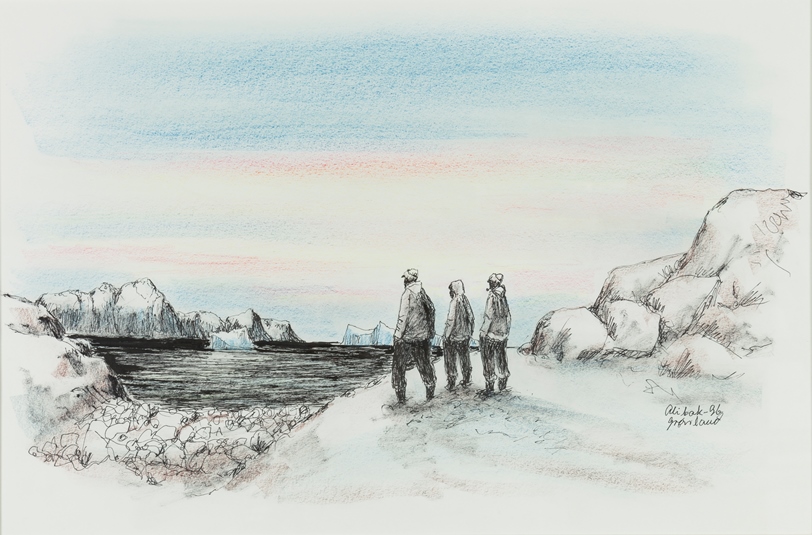Alibak was a popular artist and drawer in Greenland, whose works have been hanging in the homes of many. There are four pieces by Alibak Johansen in the collection of Nuuk Art Museum. Two are portraits, the other two landscapes. The portraits were realized with black ink in 1996, while the landscapes are different, one dating back to 1968, the other to 1996.
A firm stroke
Alibak began to draw while he was working in the weather station in Aasiaat, in the late 1940s. His drawings were then purchased by Danish colleagues in town, while other illustrations of comical everyday situations were printed as caricatures in a local newspaper. One day the town’s priest ventured to tell Alibak he had a talent for drawing and that he would gladly write to the authorities in Denmark on Alibak’s behalf, demanding for him to be sent to art school there. Unsure of what that actually meant for him, Alibak said yes to the priest. The application was eventually granted and he left for Denmark. During his education, Alibak discovered to be particularly skilled in capturing and rapidly reproducing people’s faces. In his publication, Alibak ’92, one can find several portraits from Denmark, Faroe Islands, and Greenland. Quick sketches, drawn with a firm stroke. Facial traits, hair and the collar of clothes are drawn rapidly with a pencil or a ballpoint pen.
When Alibak came back to Greenland after his art education in Denmark, he started drawing his forefathers. He wanted to show their beautiful hair, which they would set by themselves, without the help of a hairdresser. Likewise it mattered to him to depict their functional work clothes. He told in an interview that he wanted to show the lower end of the anorak’s backside. It had to cover one’s back without letting the skin being exposed, for example when working bent onwards.
Portraits
One of the two portraits in the museum’s collection is of a woman in profile, seen from the back rather than from the front. The woman wears a hairband and has her hair collected in a classical top knot; she also wears a fur collar. The portrait is drawn with black ink on white paper. The other portrait is of a man, drawn from the same viewpoint as the woman, and likewise in black ink. Both drawings are from 1996, so the two were plausibly drawn as a couple. The man has a pipe in his mouth, and out if it comes smoke. Like the woman, the man wears a fur collar too. Their faces display no feelings – neither an elusive smile on their lips, nor a scowl with their eyes.
Popular prints and posters
Many of Alibak’s works have been printed, both as art prints and as posters, especially the portraits in black. They have been very popular and can still be found in different shops and online auctions alike. Several of the portraits have even been reproduced as embroidery patterns.
He drew on paper, as that was what he could mainly afford, also after he had come back from Denmark. He used ballpoint pen, ink, pencils, and India ink. He applied colours with Filia crayons and watercolours. He used only few colours every time, indeed many of his works are uncoloured.
Landscapes
Alibak travelled a lot, not least in Greenland. In Greenland he drew many well-known mountains, including of course Sermitsiaq, Nuuk´s landmark.
One of the landscape drawings in the museum’s collection – the one from 1968 – depicts on the other hand an unspecified location with a view of the sea. On the left of the image we can see a rudimentary construction. In the calm waters is an iceberg, and a mountain chain stretches on the horizon. Alibak coloured the water and sky in blue, and used brown tones for the ground. It resembles a landscape during autumn, and feels like a view Alibak saw with his own eyes.
In the other landscape, from 1996, three men stand and look out at sea. They all turn their back on us and hold their hands in the pockets. They wear anoraks. The landscape is drawn with India ink and is less detailed than the previous work; it is lightly coloured, with the sky suggesting that the day is drawing to a close – or maybe the contrary. Crayons were used for colouring here. Looking at this piece one has the impression it does not depict a specific place and that the three men are not anyone Alibak had really met. The work was rather drawn to show a Greenlandic landscape. The beautiful landscape with figures arranged in it suggests connections with the works of expedition painters and “Greenland painters”, which often created romantic images with grand landscape and arranged figures.
Places and buildings
Alibak also drew towns and constructions all around Greenland, always with his firm stroke. The sharp edges of houses – roofs, windows, doors – and diverse shapes of mountains are drawn in such way that one can easily recognize the different places. One could almost see the drawings of towns and settlements as portraits of the places Alibak visited.
Sources
Johansen, Alibak, 1992: alibak ’92. Atuakkiorfik.
KNR, tv, June 1993: Alibak Johansen. Producer: Niels Henrik Lynge.
“Behind the Art – Alibak Johansen” is written by Hanne Kirkegaard. 2019.

